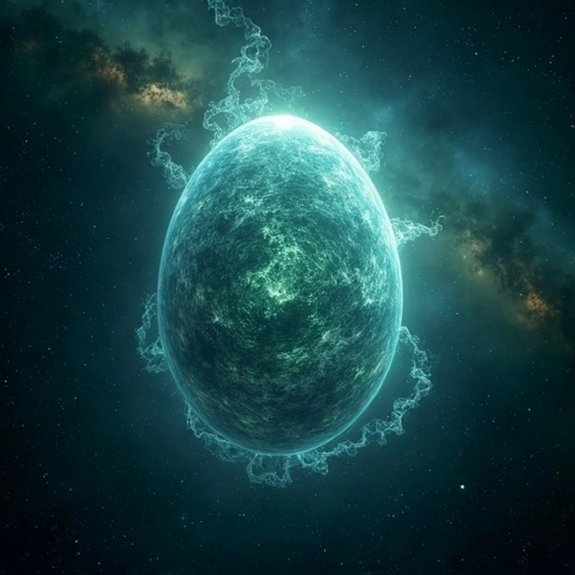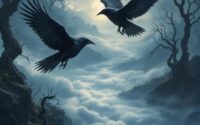The Story of the Cosmic Egg
The cosmic egg floats in primordial darkness, holding within its shell the seeds of all existence. Cultures across the world’ve independently developed this creation myth, each adding unique elements to explain how the universe burst forth from a single source. What’s particularly striking about these stories isn’t just their similarity—it’s what they reveal about humanity’s deepest questions. The answers lie hidden in ancient texts that challenge modern understanding.
Introduction

Many ancient civilizations envisioned the universe’s birth as a cosmic egg cracking open to release all of existence. This powerful creation myth appears across cultures separated by vast distances and time periods. From Hindu scriptures to Finnish folklore, from Chinese mythology to Orphic traditions in ancient Greece, the cosmic egg represents primordial unity before the world’s formation.
The symbol’s widespread occurrence suggests humanity’s shared need to explain existence through accessible metaphors. An egg contains life’s potential within a perfect, self-contained form. It transforms from singular wholeness into complex multiplicity. Ancient peoples recognized these qualities and applied them to cosmological questions. They’ve crafted narratives where divine beings emerge from cosmic shells, where heaven and earth split from a primeval ovoid, and where universal order springs from initial chaos contained within an egg-like boundary.
Ancient Hindu Creation Myths
The Rigveda describes the universe’s origin as Hiranyagarbha—the golden womb or golden egg—floating in primordial darkness for a cosmic year before splitting into heaven and earth. From this cosmic egg emerged Brahma, the creator deity who’d shape all existence. The Upanishads expand this concept, presenting the egg as containing the blueprint for everything that’d ever exist—gods, humans, animals, and the physical world itself.
Hindu texts detail how the egg’s upper half became the heavens while its lower half formed the earth. Between them, Brahma created the atmosphere. The egg’s golden yolk transformed into the sun, bringing light to creation. This myth establishes fundamental Hindu concepts: cyclical time, the unity of all existence, and the universe’s periodic destruction and rebirth through infinite cosmic cycles.
Notable Cases or Sightings

How did ancient astronomers interpret unexplained celestial phenomena through the lens of cosmic egg mythology? They’ve documented several intriguing observations that they believed validated their cosmological beliefs. Chinese astronomers in 185 CE recorded a “guest star” that appeared egg-shaped before transforming into a supernova, which they interpreted as a cosmic egg hatching new celestial bodies. Persian scholars noted oval-shaped nebulae resembled divine eggs floating in space’s darkness.
Medieval Arab astronomers observed elliptical galaxies through early telescopes and declared they’d found Brahma’s original cosmic eggs. In 1572, Tycho Brahe’s detailed drawings of a comet’s elliptical trajectory convinced many it was a fragment of the primordial egg’s shell. These interpretations weren’t random; they reflected humanity’s attempt to understand the universe through familiar metaphors.
Common Theories or Explanations
While modern cosmologists don’t interpret the universe as a literal egg, they’ve identified striking parallels between ancient cosmic egg myths and contemporary theories about the universe’s origin and structure. The Big Bang theory mirrors the egg’s explosive hatching, with the universe expanding from an infinitely dense singularity. Some physicists compare the observable universe’s shape to an oblate spheroid—essentially egg-shaped—due to cosmic inflation patterns.
Jungian psychologists interpret the cosmic egg as humanity’s collective unconscious attempting to grasp incomprehensible cosmic origins through familiar biological metaphors. They argue that birth imagery naturally emerges when cultures contemplate creation. Meanwhile, comparative mythologists suggest the egg symbol arose independently across civilizations because it’s the most observable example of life emerging from apparent nothingness, making it the perfect metaphor for existence itself.
Frequently Asked Questions
How Does the Cosmic Egg Concept Relate to Modern Big Bang Theory?
Scientists recognize striking parallels between ancient cosmic egg myths and Big Bang cosmology. Both describe the universe’s birth from a singular, dense point that expanded outward. They’ve noted this convergence of mythological intuition and scientific discovery.
What Artistic Representations of the Cosmic Egg Exist Throughout History?
Artists’ve depicted cosmic eggs in Hindu mandalas, Egyptian hieroglyphs showing Ra emerging from golden eggs, medieval alchemical illustrations, Salvador Dalí’s “Geopoliticus Child,” and contemporary installations exploring creation myths through ovoid sculptures and paintings.
Are There Any Archaeological Artifacts Depicting the Cosmic Egg?
Yes, archaeologists’ve discovered several artifacts depicting cosmic eggs. They’ve found ancient Egyptian scarabs showing eggs with deities emerging, Hindu temple carvings featuring Hiranyagarbha, and Chinese bronze vessels decorated with primordial egg motifs from various dynasties.
How Do Different Cultures’ Cosmic Egg Myths Compare to Each Other?
Different cultures’ cosmic egg myths share core themes but vary in details. They’ll typically feature primordial waters, divine beings emerging from eggs, and creation through splitting. Hindu, Chinese, Finnish, and Egyptian versions emphasize cosmic order’s birth.
What Rituals or Ceremonies Traditionally Honor the Cosmic Egg Creation Story?
Various cultures honor cosmic egg myths through spring equinox celebrations, egg decorating rituals, and harvest ceremonies. They’ll paint eggs with sacred symbols, perform creation dances, and share origin stories during seasonal festivals marking renewal cycles.


